So, last time, I explained the basic Rubik's Cube. As well as my method: only 2 algorithms, but they are VERSATILE. They can be used in many ways... and on almost any puzzle. It's just a matter of figuring out HOW to use them, and making slight tweaks if needed. Which is good, because now things get funky.
Case in point, the Megaminx:
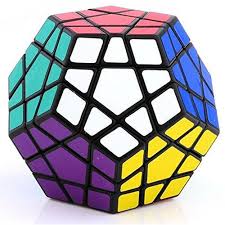
This intimidating thing is often the second puzzle for those into this hobby (well, those who are into it beyond just the speed aspect). Many more sides than the normal cube.
In truth, it's not a very hard puzzle. And that method I use, it indeed works here, though some bits are different. That final step with the 3 corners is for the original cube... that doesnt happen here. Instead the final part of this solve is... a bit confusing to explain. I wont go into detail. And of course, the "normal" method differs wildly from what I do. But one way or another, however you go about it, you'll get the hang of it sooner rather than later.
Now, it's time to get to the crazy stuff. The tough ones, designed to confuse. I can show all sorts of cool examples here.
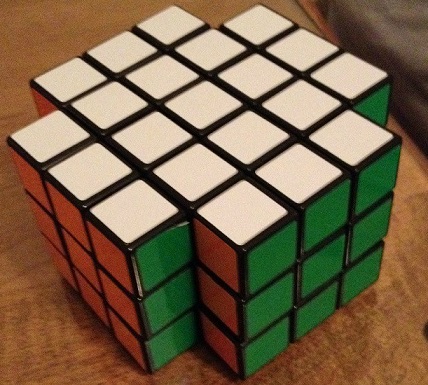
This monstrosity is called an X-cube. Cant imagine why.
When it is scrambled, it does this:
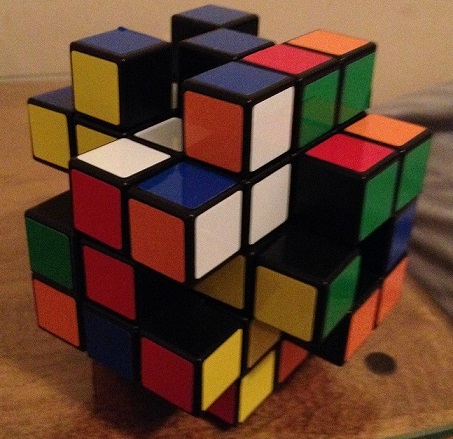
Pretty crazy, yeah? This one was the first major challenge I had after dealing with the basic cube.
This type of cube is known as a shapeshifter. That's right, there's an entire category of puzzles that do this. Shapeshifters are confusing.
But you know what, it's not that hard to deal with. Often, with a shapeshifter, the first goal is to "flatten" it. Basically, to simply get that original shape back. It'll still be a scrambled mess, but once it's back in normal form, you can then start to actually unscramble it. This one is not too hard to figure out, and a good introduction to this type of puzzle.
Let's look at another:
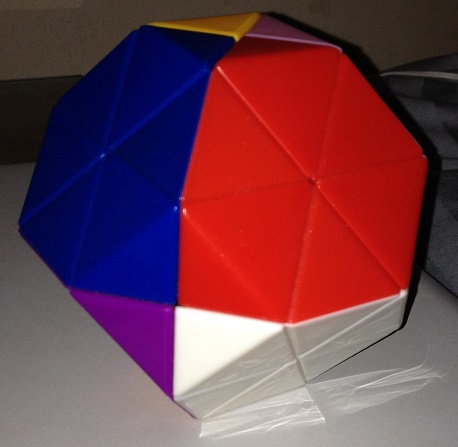
This thing is a Dayan Gem. Notice something? There are no "center" pieces on each face. That's because for this one, the EDGES spin. So that bit that's facing the camera, half blue and half red, that spins. This is the first thing that is likely to confuse.
But this is another shapeshifter. However, a more complicated type.
Once this is fully scrambled, it does this:
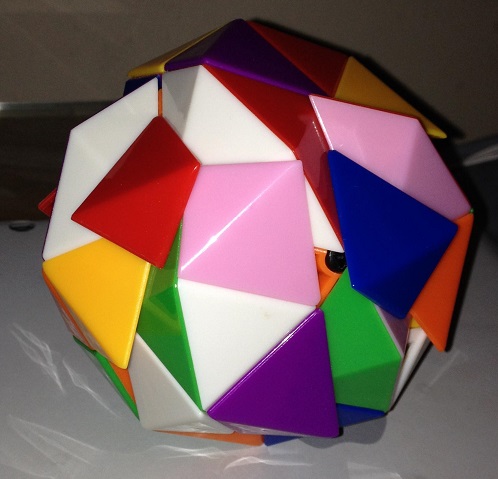
Mere spinning cant cause THAT!
This isnt just a shapeshifter. It is also a "jumbling" puzzle. With most puzzles, you twist a given part, and that's it. Said part can only be twisted in one way. The pieces spin around, they dont come apart or anything.
But a jumbling puzzle is different. Imagine the normal Rubik's cube, right? What if, instead of rotating a side 90 degrees, you only rotated it 40 degrees. And then you tried to rotate an adjacent side. Nothing would happen! The partially rotated side would block it.
But here, you can do that. By rotating one of those edge blocks partially, and then rotating an adjacent one partially, you can then sort of "twist" parts of it, where the two come together. This actually causes seperate pieces to DISLODGE. Yet, they will stick to other parts of the puzzle. If you look at that second image, you can see that lone red piece on the left. It is completely dislodged from any others, yet if you rotate the green/white bit under it, the red one will travel with it.
Well, to a point. Part of the challenge of a jumbling puzzle is that, once it's jumbled enough, it will actually start to lock up. Dislodged pieces start to get in the way, preventing parts of the puzzle from turning.
Solving one of these has a few steps: firstly, flatten it. Get it back into the basic shape. Second, dislodge individual pieces, and... er.... re-lodge them back with the blocks they're actually supposed to go in. This leaves you with a "normal" scramble. From there, you can then actually solve it. There are many types of jumblers. This is one of the easier ones.
Time for something different:
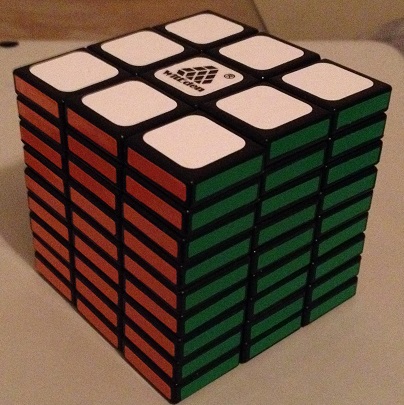
This is a squashed 3x3x9. "Squashed" because it's not in a cuboid shape. As in, each individual piece is not a perfect cube, yet it still remains cubic.
This thing turns like a normal Rubik's cube. Except that you can also spin the individual slices. Well... until you do this:

What a mess! That is ALOT of pieces that need to be moved around. But individual "slices" cant move like that! It's all blocked up.
This loopy thing actually isnt all that hard... by this point, I was used to this stuff. And like I said, those two "moves" I know.... they're used on everything. HOWEVER. You cant JUST use those two. You'll have to manipulate these puzzles in other ways too. If you're using the method I use, many of the twists and turns you make wont actually be part of an algorithm. You only apply the two special "moves" at appropriate times. That's how it is for any puzzle, with this method.
This puzzle ends up being a very long solve (with so many pieces), but it's one I really like. There are actually many variations of this one, as it was quite popular. Other variations throw various screwy elements into the mix to complicate it further.
Now things get extra weird:
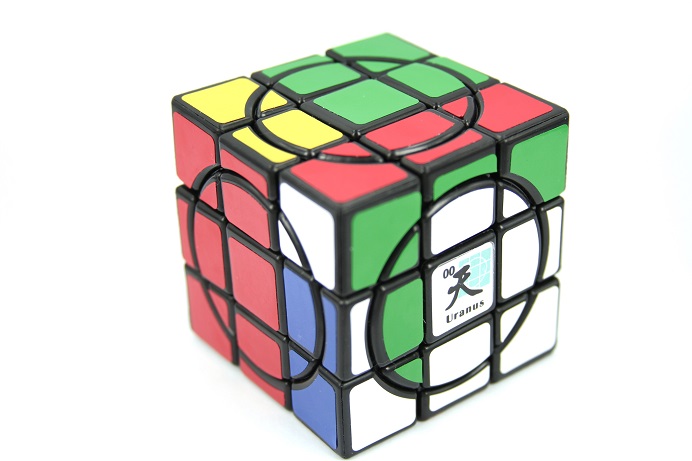
This is a "crazy planet cube". There are 8 of these... each named after a planet, because.... because. They all look the same. They arent.
There are actually 2 types of sides on the cube. Often called "0" or "1". With a "0" side, when you turn it, the bits within the circle DO NOT move. They remain stationary... this is how you get individual pieces split up, like on the front side in the picture. But on a "1" side, the bits in the circle DO spin.
This means that not only do you have these weird splitting pieces, but different sides function differently! This is why there are 8 of them. They all LOOK the same, but they each feature a different arrangement of the 2 types of sides.
This can get even weirder. That "squashed 3x3x9" with all the slices? Yeah. There's a version of that which does this circle thing too.
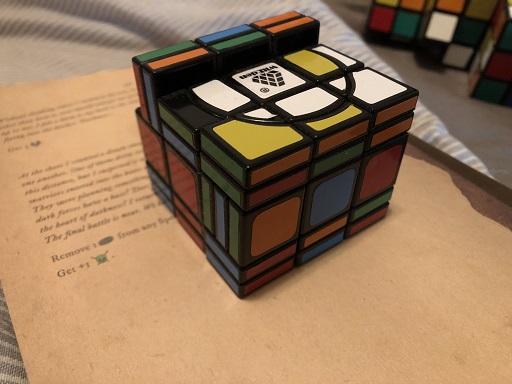
Oh yeah. Now it's getting weird.
It's that sliced up thing, but 2 sides have the circles on them. But also, notice one other thing: It's not a perfect cube! Needless to say, this is a strange one. It's also not the only one like this. There's another variation with only ONE circle, on the white side. Yet that circle will still mix with non-circle yellow bits. It's hard to explain HOW it does that without showing it, but suffice it to say... they take the idea a few steps further.
Now let's get REALLY weird!
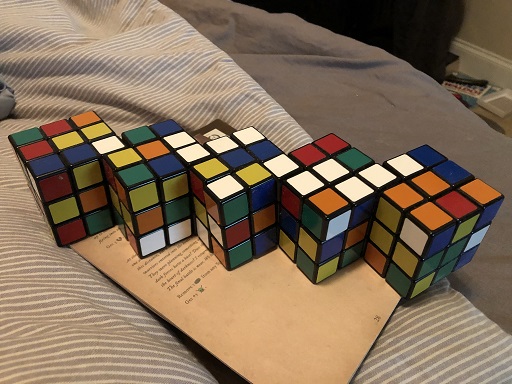
The idea of a "conjoined" puzzle isnt new. Jamming 2 cubes together to form one puzzle... it's been done. But FIVE of them? What the heck, right?
This is as hard as it looks. No, I've not solved this. Why is it so hard? Well.. that goes into another puzzling concept that I'll save for another time. We'll get to "bandaged" puzzles then. Though this isnt a true bandaged cube, the conjoined aspect produces a similar effect.
Now let's end with a bang here.
First, I'll show this:
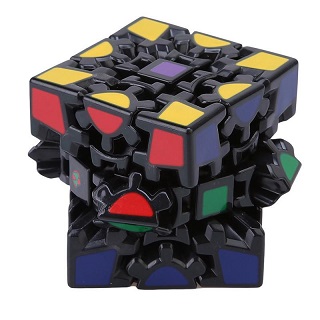
This is a Gear Cube. Surely you can see why it's called that.
Here's the thing. It doesnt turn normally. When you spin any one side, the "middle" bit will also spin... but slower. A full rotation of one side will leave the middle at a 45 degree angle. So, turning this thing is a little weird. You must make 2 full rotations before the center is at a proper angle again, so that other types of turns can be done.
Oddly, this is actually pretty easy. There are some puzzles where, even if you dont quite know what you're doing, you'll be turning it and find that random bits of it have come together. A bit more experimenting, and you've got it. It's such a cool concept, but nowhere near as hard as it looks.
But then there's this:
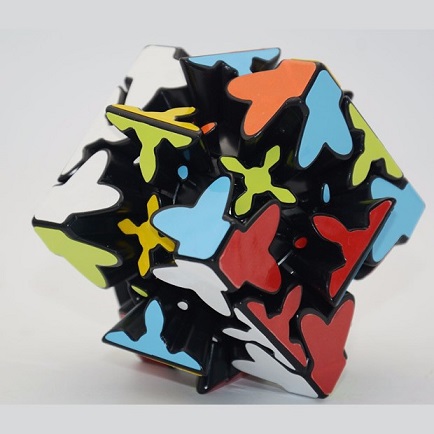
This monstrosity is called a Geared Mixup Cube. A "mixup" puzzle is a whole seperate thing. The idea being that the "middle" of the puzzle... which normally doesnt have gears... can be at a 45 degree angle, and then literally split. The split parts can then be mashed together and such, yet only the middle bits get weird like that. There are many variations of mixup puzzles.
But a GEARED mixup? Hoboy.
This is by far the hardest puzzle in my collection. I wont lie: I dont understand this thing.
Just to illustrate how loopy it gets: I saw a solve tutorial on this one, complete with algorithms the guy had come up with to make it work. ONE algorithm... just one... was over 100 individual turns long. It needed to be performed multiple times. And that's just one algorithm. There are others. Needless to say, I didnt use the method in the video.
Interestingly, the "ultimate" method I use DOES apply to this thing, but... good luck understanding HOW. This puzzle, overall, is beyond my current ability.
Puzzles like the ones I've shown here illustrate just how varied the hobby is, and how incredibly creative the people are that design these things. Believe me, they only get weirder from here.
But it's not all ultra-confusing things. There are some puzzles made to be quite easy. Ones that are more about a relaxing experience, instead of making your brain dribble out your ears.
Or some that are just designed to look amazing.
As an example:
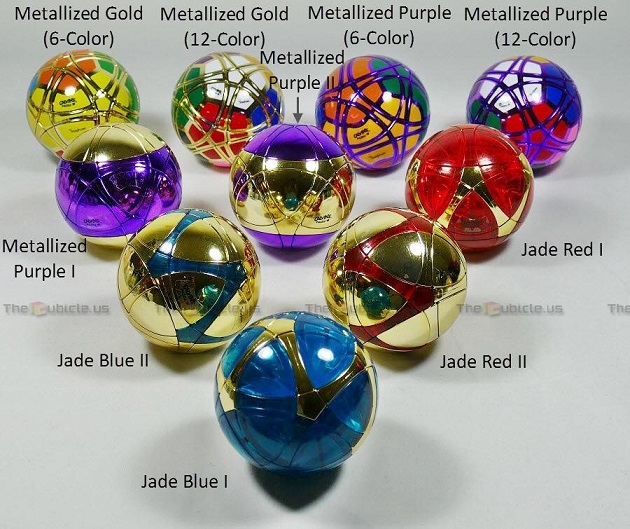
Remember the Megaminx? That's what these are. Yes, all of them. They work EXACTLY the same.... they've just been rounded. And metallized! I have a couple of these, and they really do look incredible.
Later on, I'll do another puzzle post, and I'll go into some like this, and some that are meant to be easier things.
But for now... I think that'll do.
Case in point, the Megaminx:

This intimidating thing is often the second puzzle for those into this hobby (well, those who are into it beyond just the speed aspect). Many more sides than the normal cube.
In truth, it's not a very hard puzzle. And that method I use, it indeed works here, though some bits are different. That final step with the 3 corners is for the original cube... that doesnt happen here. Instead the final part of this solve is... a bit confusing to explain. I wont go into detail. And of course, the "normal" method differs wildly from what I do. But one way or another, however you go about it, you'll get the hang of it sooner rather than later.
Now, it's time to get to the crazy stuff. The tough ones, designed to confuse. I can show all sorts of cool examples here.

This monstrosity is called an X-cube. Cant imagine why.
When it is scrambled, it does this:

Pretty crazy, yeah? This one was the first major challenge I had after dealing with the basic cube.
This type of cube is known as a shapeshifter. That's right, there's an entire category of puzzles that do this. Shapeshifters are confusing.
But you know what, it's not that hard to deal with. Often, with a shapeshifter, the first goal is to "flatten" it. Basically, to simply get that original shape back. It'll still be a scrambled mess, but once it's back in normal form, you can then start to actually unscramble it. This one is not too hard to figure out, and a good introduction to this type of puzzle.
Let's look at another:

This thing is a Dayan Gem. Notice something? There are no "center" pieces on each face. That's because for this one, the EDGES spin. So that bit that's facing the camera, half blue and half red, that spins. This is the first thing that is likely to confuse.
But this is another shapeshifter. However, a more complicated type.
Once this is fully scrambled, it does this:

Mere spinning cant cause THAT!
This isnt just a shapeshifter. It is also a "jumbling" puzzle. With most puzzles, you twist a given part, and that's it. Said part can only be twisted in one way. The pieces spin around, they dont come apart or anything.
But a jumbling puzzle is different. Imagine the normal Rubik's cube, right? What if, instead of rotating a side 90 degrees, you only rotated it 40 degrees. And then you tried to rotate an adjacent side. Nothing would happen! The partially rotated side would block it.
But here, you can do that. By rotating one of those edge blocks partially, and then rotating an adjacent one partially, you can then sort of "twist" parts of it, where the two come together. This actually causes seperate pieces to DISLODGE. Yet, they will stick to other parts of the puzzle. If you look at that second image, you can see that lone red piece on the left. It is completely dislodged from any others, yet if you rotate the green/white bit under it, the red one will travel with it.
Well, to a point. Part of the challenge of a jumbling puzzle is that, once it's jumbled enough, it will actually start to lock up. Dislodged pieces start to get in the way, preventing parts of the puzzle from turning.
Solving one of these has a few steps: firstly, flatten it. Get it back into the basic shape. Second, dislodge individual pieces, and... er.... re-lodge them back with the blocks they're actually supposed to go in. This leaves you with a "normal" scramble. From there, you can then actually solve it. There are many types of jumblers. This is one of the easier ones.
Time for something different:

This is a squashed 3x3x9. "Squashed" because it's not in a cuboid shape. As in, each individual piece is not a perfect cube, yet it still remains cubic.
This thing turns like a normal Rubik's cube. Except that you can also spin the individual slices. Well... until you do this:

What a mess! That is ALOT of pieces that need to be moved around. But individual "slices" cant move like that! It's all blocked up.
This loopy thing actually isnt all that hard... by this point, I was used to this stuff. And like I said, those two "moves" I know.... they're used on everything. HOWEVER. You cant JUST use those two. You'll have to manipulate these puzzles in other ways too. If you're using the method I use, many of the twists and turns you make wont actually be part of an algorithm. You only apply the two special "moves" at appropriate times. That's how it is for any puzzle, with this method.
This puzzle ends up being a very long solve (with so many pieces), but it's one I really like. There are actually many variations of this one, as it was quite popular. Other variations throw various screwy elements into the mix to complicate it further.
Now things get extra weird:

This is a "crazy planet cube". There are 8 of these... each named after a planet, because.... because. They all look the same. They arent.
There are actually 2 types of sides on the cube. Often called "0" or "1". With a "0" side, when you turn it, the bits within the circle DO NOT move. They remain stationary... this is how you get individual pieces split up, like on the front side in the picture. But on a "1" side, the bits in the circle DO spin.
This means that not only do you have these weird splitting pieces, but different sides function differently! This is why there are 8 of them. They all LOOK the same, but they each feature a different arrangement of the 2 types of sides.
This can get even weirder. That "squashed 3x3x9" with all the slices? Yeah. There's a version of that which does this circle thing too.

Oh yeah. Now it's getting weird.
It's that sliced up thing, but 2 sides have the circles on them. But also, notice one other thing: It's not a perfect cube! Needless to say, this is a strange one. It's also not the only one like this. There's another variation with only ONE circle, on the white side. Yet that circle will still mix with non-circle yellow bits. It's hard to explain HOW it does that without showing it, but suffice it to say... they take the idea a few steps further.
Now let's get REALLY weird!

The idea of a "conjoined" puzzle isnt new. Jamming 2 cubes together to form one puzzle... it's been done. But FIVE of them? What the heck, right?
This is as hard as it looks. No, I've not solved this. Why is it so hard? Well.. that goes into another puzzling concept that I'll save for another time. We'll get to "bandaged" puzzles then. Though this isnt a true bandaged cube, the conjoined aspect produces a similar effect.
Now let's end with a bang here.
First, I'll show this:

This is a Gear Cube. Surely you can see why it's called that.
Here's the thing. It doesnt turn normally. When you spin any one side, the "middle" bit will also spin... but slower. A full rotation of one side will leave the middle at a 45 degree angle. So, turning this thing is a little weird. You must make 2 full rotations before the center is at a proper angle again, so that other types of turns can be done.
Oddly, this is actually pretty easy. There are some puzzles where, even if you dont quite know what you're doing, you'll be turning it and find that random bits of it have come together. A bit more experimenting, and you've got it. It's such a cool concept, but nowhere near as hard as it looks.
But then there's this:

This monstrosity is called a Geared Mixup Cube. A "mixup" puzzle is a whole seperate thing. The idea being that the "middle" of the puzzle... which normally doesnt have gears... can be at a 45 degree angle, and then literally split. The split parts can then be mashed together and such, yet only the middle bits get weird like that. There are many variations of mixup puzzles.
But a GEARED mixup? Hoboy.
This is by far the hardest puzzle in my collection. I wont lie: I dont understand this thing.
Just to illustrate how loopy it gets: I saw a solve tutorial on this one, complete with algorithms the guy had come up with to make it work. ONE algorithm... just one... was over 100 individual turns long. It needed to be performed multiple times. And that's just one algorithm. There are others. Needless to say, I didnt use the method in the video.
Interestingly, the "ultimate" method I use DOES apply to this thing, but... good luck understanding HOW. This puzzle, overall, is beyond my current ability.
Puzzles like the ones I've shown here illustrate just how varied the hobby is, and how incredibly creative the people are that design these things. Believe me, they only get weirder from here.
But it's not all ultra-confusing things. There are some puzzles made to be quite easy. Ones that are more about a relaxing experience, instead of making your brain dribble out your ears.
Or some that are just designed to look amazing.
As an example:

Remember the Megaminx? That's what these are. Yes, all of them. They work EXACTLY the same.... they've just been rounded. And metallized! I have a couple of these, and they really do look incredible.
Later on, I'll do another puzzle post, and I'll go into some like this, and some that are meant to be easier things.
But for now... I think that'll do.
